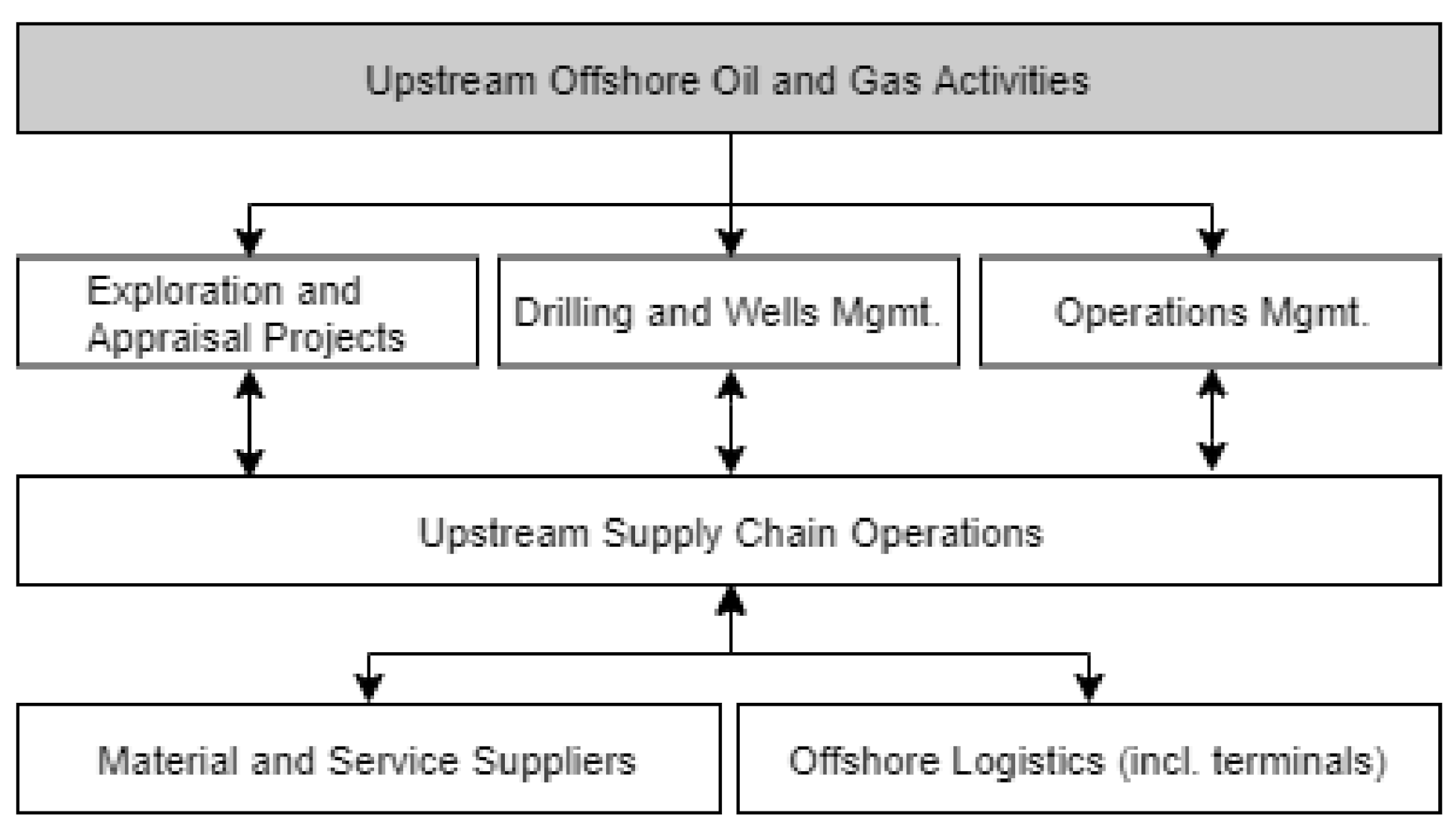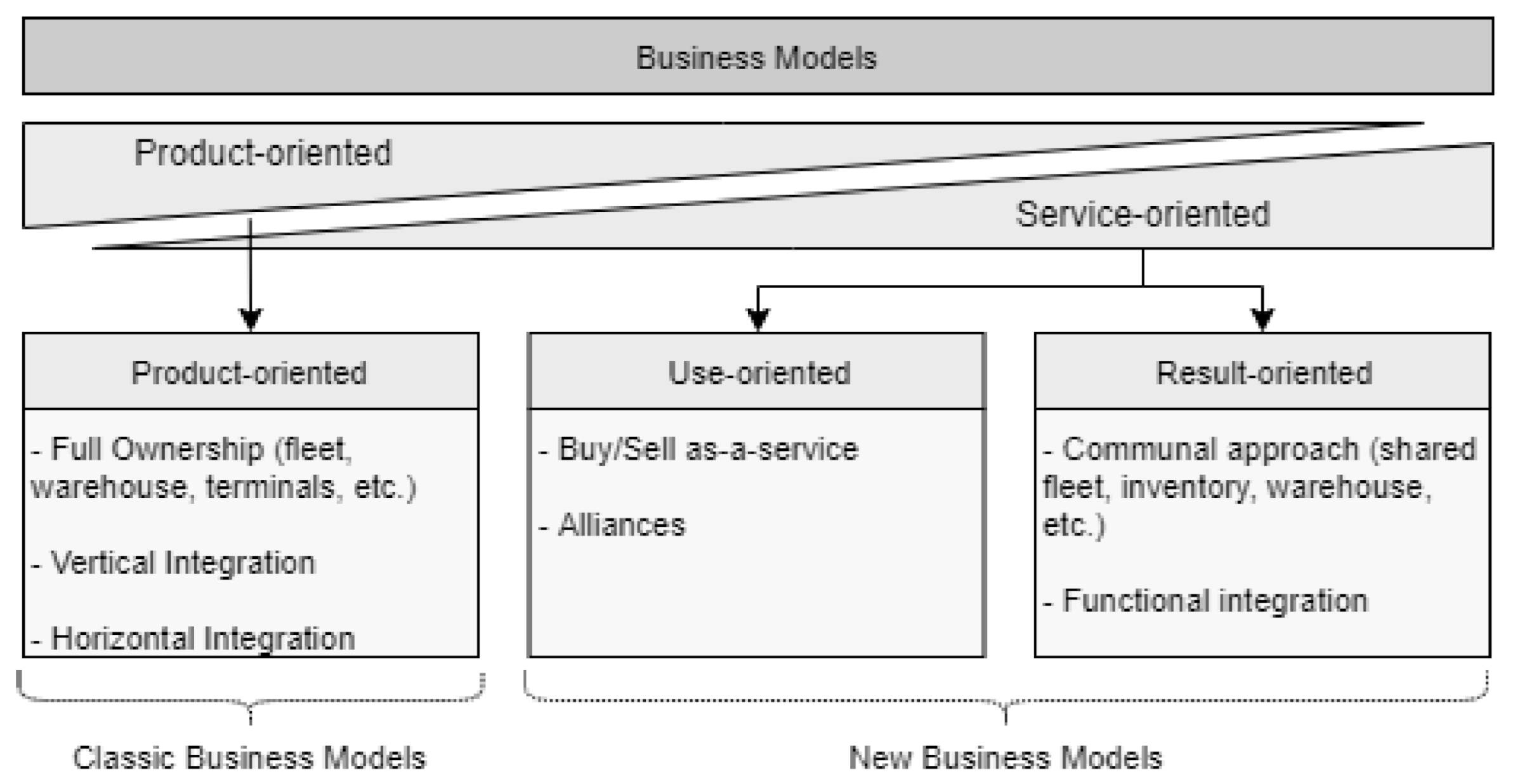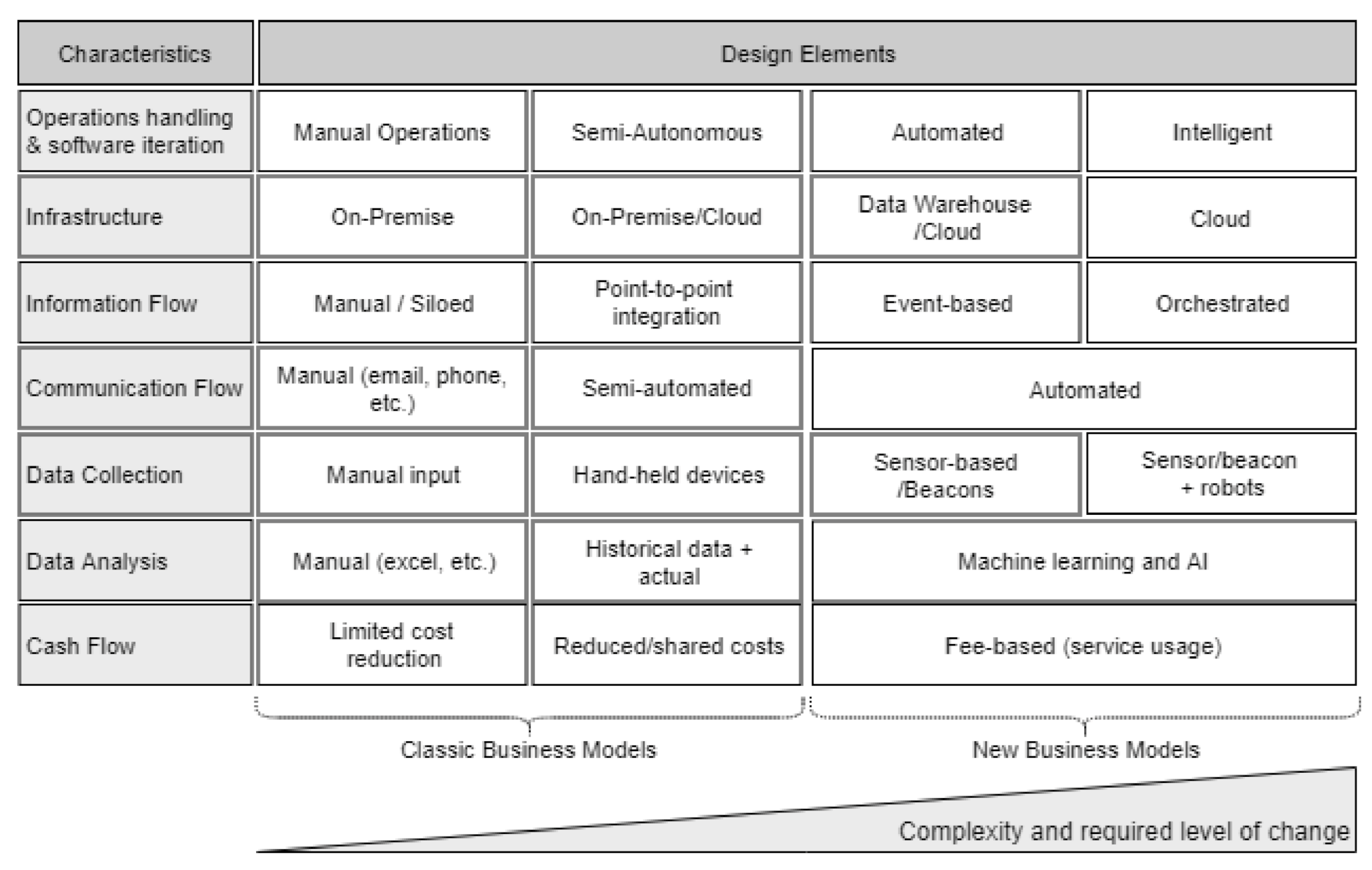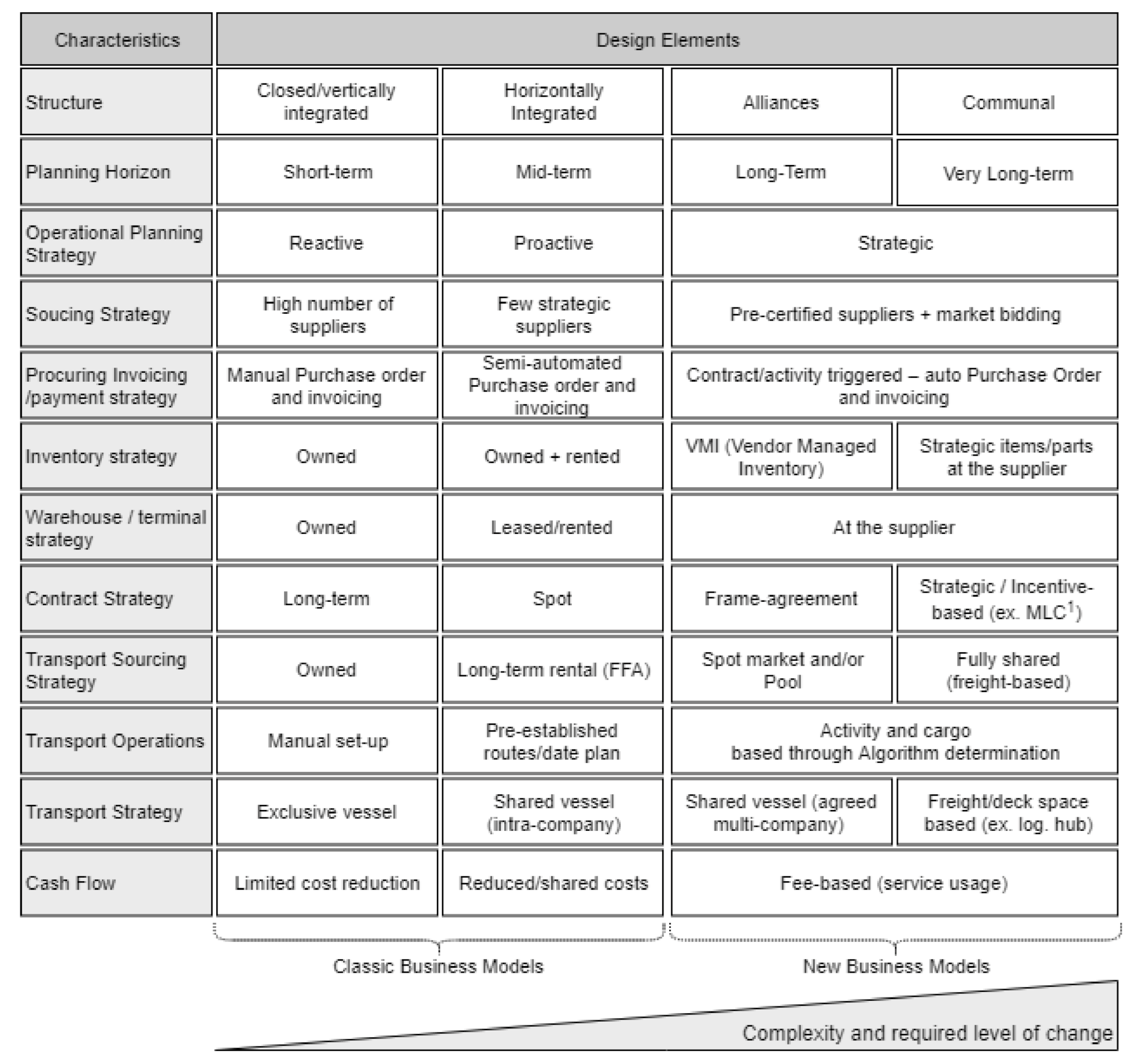Cleaning Up Our Act: Systems Engineering to Promote Business Model Innovation for the Offshore Exploration and Production Supply Chain Operations
Abstract
1. Introduction
2. Materials and Methods
3. Results
3.1. Technology-Related Elements: Characteristics and Contributions to SDGs
3.2. Organization-Related Elements: Characteristics and Contributions to SDGs
3.3. Human Element-Related Elements: Characteristics and Contributions to SDGs
4. Discussion
4.1. Value Proposition
4.2. Value Creation
4.3. Value Capture
4.4. SDGs
5. Conclusions
Funding
Institutional Review Board Statement
Informed Consent Statement
Data Availability Statement
Acknowledgments
Conflicts of Interest
References
- Cassagne, T.; International Petroleum Industry Environmental Conservation Association; International Association of Oil & Gas Producers. Environmental Management in the Upstream Oil and Gas Industry; IOGP: London, UK, 2020. [Google Scholar]
- Alvik, S.; Bakken, B.E.; Onur, O.; Horschig, H.; Koefoed, A.L.; McConnel, E.; Rinaldo, M.; Shafiei, E.; Zwarts, R.J. Energy Transition Outlook 2020—A Global and Regional Forecast to 2050; DNV GL: Hovik, Norway, 2020. [Google Scholar]
- International Energy Agency. The Oil and Gas Industry in Energy Transitions: Insights from IEA Analysis; IEA: Amsterdam, The Netherlands, 2020. [Google Scholar]
- Alvik, S.; Bakken, B.E.; Onur, O.; Horschig, H.; Koefoed, A.L.; McConnel, E.; Rinaldo, M.; Shafiei, E.; Zwarts, R.J. Energy Transition Outlook 2020—Power Supply and Use; DNV GL: Hovik, Norway, 2020. [Google Scholar]
- Rodrigue, J.-P. The Geography of Transport Systems, 5th ed.; Routledge: New York, NY, USA, 2020. [Google Scholar]
- Demirbas, A.; Bafail, A.; Nizami, A.-S. Heavy oil upgrading: Unlocking the future fuel supply. Pet. Sci. Technol. 2016, 34, 303–308. [Google Scholar] [CrossRef]
- U.S Energy Information Administration. Energy Use for Transportation. Use of Energy Explained. 2020. Available online: https://www.eia.gov/energyexplained/use-of-energy/transportation.php#:~:text=Petroleum is the main source,in natural gas pipeline compressors (accessed on 19 November 2020).
- Oil Industry International Exploration and Production Forum; United Nations Environment Programme Industry and Environment Centre. Environmental Management in Oil and Gas Exploration and Production: An Overview of Issues and Management Approaches; UNEP: Oxford, UK, 1997. [Google Scholar]
- United Nations Development Programme; International Finance Corporation; International Petroleum Industry Environmental Conservation Association; Center on Sustainable Investment. Mapping the Oil and Gas Industry to the Sustainable Development Goals: An Atlas. United Nations. 2017. Available online: http://www.ipieca.org/resources/awareness-briefing/mapping-the-oil-and-gas-industry-to-the-sustainable-development-goals-an-atlas/ (accessed on 19 November 2020).
- United Nations. United Nations Sustainable Development Goals—Climate Change. UN Knowledge Platform. 2015. Available online: https://sustainabledevelopment.un.org/post2015/transformingourworld/publication (accessed on 19 November 2020).
- Zalasiewicz, J.; Williams, M.; Steffen, W.; Crutzen, P. The new world of the anthropocene. Environ. Sci. Technol. 2010, 44, 2228–2231. [Google Scholar] [CrossRef] [PubMed]
- Van Dokkum, K. Ship Knowledge—A Modern Encylopedia; Dokmar: Enkhuzien, The Netherlands, 2003. [Google Scholar]
- Inkpen, A.; Moffett, M.H. The Global Oil & Gas Industry: Management, Strategy & Finance; PennWell Books: St. Tusla, OK, USA, 2011. [Google Scholar]
- Aas, B.; Halskau, Ø., Sr.; Wallace, S.W. The role of supply vessels in offshore logistics. Marit. Econ. Logist. 2009, 11, 302–325. [Google Scholar] [CrossRef]
- Olesen, T.R. Offshore Supply Industry Dynamics: Business Strategies in the Offshore Supply Industry; Copenhagen Business School: Copenhagen, Denmark, 2016. [Google Scholar]
- Stopford, M. Maritime Economics; Routledge: New York, NY, USA, 2013. [Google Scholar]
- American Petroleum Institute; International Association of Oil & Gas Producers. Sustainability Reporting Guidance for the Oil and Gas Industry. 2020. Available online: https://www.ipieca.org/media/5115/ipieca_sustainability-guide-2020.pdf (accessed on 19 November 2020).
- Jære, L.; Norwegian Environment Agency. Environmental Impact of Oil and Gas Activities. BarentsWatch. 25 August 2016. Available online: https://www.barentswatch.no/en/articles/Environmental-impact-of-oil-and-gas-activities/ (accessed on 19 November 2020).
- Bech, C.; Rashidbeigi, S.; Roelofsen, O.; Speelman, E. The future is now: How oil and gas companies can decarbonize. McKinsey. 7 January 2020. Available online: https://www.mckinsey.com/industries/oil-and-gas/our-insights/the-future-is-now-how-oil-and-gas-companies-can-decarbonize (accessed on 21 November 2020).
- Baden-Fuller, C.; Haefliger, S. Business models and technological innovation. Long Range Plan. 2013, 46, 419–426. [Google Scholar] [CrossRef]
- Forbes-Cable, M.; Liu, W. Digital Disruption: Upstream Supply Chain Threats and Opportunities. Available online: https://www.woodmac.com/reports/upstream-oil-and-gas-digital-disruption-upstream-supply-chain-threats-and-opportunities-310260/ (accessed on 19 November 2020).
- World Economic Forum and Accenture. Digital Transformation Initiative—Oil and Gas Industry. 2017. Available online: http://reports.weforum.org/digital-transformation (accessed on 19 November 2020).
- Eglash, S.; Fisher, K. Sustainable Energy for All: Opportunities for the Oil and Gas Industry; Accenture: New York, NY, USA, 2012. [Google Scholar]
- Evans, S.; Vladimirova, D.; Holgado, M.; Van Fossen, K.; Yang, M.; Silva, E.A.; Barlow, C.Y. Business model innovation for sustainability: Towards a unified perspective for creation of sustainable business models. Bus. Strat. Environ. 2017, 26, 597–608. [Google Scholar] [CrossRef]
- Florescu, M.S.; Ceptureanu, E.G.; Cruceru, A.F.; Ceptureanu, S.I. Sustainable supply chain management strategy influence on supply chain management functions in the oil and gas distribution industry. Energies 2019, 12, 1632. [Google Scholar] [CrossRef]
- Al-Debei, M.M.; Avison, D. Developing a unified framework of the business model concept. Eur. J. Inf. Syst. 2010, 19, 359–376. [Google Scholar] [CrossRef]
- Zott, A.; Aamit, R. The business model: Recent developments and future research. SSRN Electron. J. 2011, 37, 1019–1042. [Google Scholar] [CrossRef]
- Bucherer, E.; Eisert, U.; Gassmann, O. Towards systematic business model innovation: Lessons from product innovation management. Creat. Innov. Manag. 2012, 21, 183–198. [Google Scholar] [CrossRef]
- Veit, D.; Clemons, E.; Benlian, A.; Buxmann, P.; Hess, T.; Kundisch, D.; Leimeister, J.M.; Loos, P.; Spann, M. Business models: An information systems research agenda. Bus. Inf. Syst. Eng. 2014, 6, 45–53. [Google Scholar]
- Arciszewski, T. Morphological analysis in inventive engineering. Technol. Forecast. Soc. Chang. 2018, 126, 92–101. [Google Scholar] [CrossRef]
- Buzuku, S.; Farfan, J.; Harmaa, K.; Kraslawski, A.; Kässi, T. A case study of complex policy design: The systems engineering approach. Complexity 2019. [Google Scholar] [CrossRef]
- Im, K.; Cho, H. A systematic approach for developing a new business model using morphological analysis and integrated fuzzy approach. Expert Syst. Appl. 2013, 40, 4463–4477. [Google Scholar] [CrossRef]
- Kwon, M.; Lee, J.; Hong, Y.S. Product-service system business modelling methodology using morphological analysis. Sustainability 2019, 11, 1376. [Google Scholar] [CrossRef]
- Zwicky, F. Discovery, Invention, Research through the Morphological Approach; MacMillan: New York, NY, USA, 1969. [Google Scholar]
- Tukker, A. Eight types of product-service system: Eight ways to sutainability? Experiences from suspronet. Bus. Strateg. Environ. 2004, 260, 246–260. [Google Scholar] [CrossRef]
- Kley, F.; Lerch, C.; Dallinger, D. New business models for electric cars—A holistic approach. Energy Policy 2011, 39, 3392–3403. [Google Scholar] [CrossRef]
- Bocken, N.M.P.; Short, S.W.; Rana, P.; Evans, S. A literature and practice review to develop sustainable business model archetypes. J. Clean. Prod. 2014, 65, 42–56. [Google Scholar] [CrossRef]
- Ahmad, N.K.W.; De Brito, M.P.; Rezaei, J.; Tavasszy, L.A. An integrative framework for sustainable supply chain management practices in the oil and gas industry. J. Environ. Plan. Manag. 2016, 60, 577–601. [Google Scholar] [CrossRef]
- Gassmann, O.; Frankenberger, K.; Csik, M. The St. Gallen business model navigator. Int. J. Prod. Dev. 2013, 18, 249–273. [Google Scholar]
- Bouncken, R.B.; Kraus, S.; Roig-Tierno, N. Knowledge- and innovation-based business models for future growth: Digitalized business models and portfolio considerations. Rev. Manag. Sci. 2019, 20, 1–14. [Google Scholar] [CrossRef]
- Osterwalder, A.; Pigneur, Y. Business Model Generation: A Handbook for Visionaries, Game Changers, and Challengers; John Wiley & Sons: Hoboken, NJ, USA, 2010. [Google Scholar]
- Chesbrough, H. The role of the business model in capturing value from innovation: Evidence from Xerox Corporation’s technology spin-off companies. Ind. Corp Chang. 2002, 11, 529–555. [Google Scholar] [CrossRef]
- Trott, P. Business Models. In Innovation Management and New Product Development, 6th ed.; Pearson: New York, NY, USA, 2017; pp. 412–444. [Google Scholar]
- Chesbrough, H. Business model innovation: Opportunities and barriers. Long Range Plan. 2010, 43, 354–363. [Google Scholar] [CrossRef]
- Morris, M.; Schindehutte, M.; Allen, J. The entrepreneur’s business model: Toward a unified perspective. J. Bus. Res. 2005, 58, 726–735. [Google Scholar] [CrossRef]
- Markides, C. Disruptive innovation: In need of better theory. J. Prod. Innov. Manag. 2006, 23, 19–25. [Google Scholar] [CrossRef]
- Joyce, A.; Paquin, R.L. The triple layered business model canvas: A tool to design more sustainable business models. J. Clean. Prod. 2016, 135, 1474–1486. [Google Scholar] [CrossRef]
- Ebneyamini, S.; Bandarian, R. Explaining the role of technology in the dynamics of the players business models in the global oil playground. Int. J. Energy Sect. Manag. 2019, 13, 556–572. [Google Scholar] [CrossRef]
- Raut, R.D.; Narkhede, B.; Gardas, B.B. To identify the critical success factors of sustainable supply chain management practices in the context of oil and gas industries: ISM approach. Renew. Sustain. Energy Rev. 2017, 68, 33–47. [Google Scholar] [CrossRef]
- Stevens, P. International Oil Companies; Chatham House: London, UK, 2016. [Google Scholar]
- Gardas, B.B.; Raut, R.D.; Narkhede, B. Determinants of sustainable supply chain management: A case study from the oil and gas supply chain. Sustain. Prod. Consum. 2019, 17, 241–253. [Google Scholar] [CrossRef]
- Wendel, D. Maritime Forecast to 2050; DNV-GL: Hovik, Norway, 2017; pp. 1–17. [Google Scholar]
- Hassani, H.; Silva, E.S.; Al Kaabi, A.M. The role of innovation and technology in sustaining the petroleum and petrochemical industry. Technol. Forecast. Soc. Chang. 1027, 119, 1–17. [Google Scholar] [CrossRef]
- Bengtsson, M.; Kock, S. “Coopetition” in Business Networks—To cooperate and compete simultaneously. Ind. Mark. Manag. 2000, 29, 411–426. [Google Scholar]
- Cooper, M.C.; Lambert, D.M.; Pagh, J.D. Supply chain management: More than a new name for logistics. Int. J. Logist. Manag. 1997, 8, 1–14. [Google Scholar] [CrossRef]
- Squire, B.; Cousins, P.D.; Brown, S. Cooperation and knowledge transfer within buyer-supplier relationships: The moderating properties of trust, relationship duration and supplier performance. Br. J. Manag. 2009, 20, 461–477. [Google Scholar] [CrossRef]
- Mackenzie, W. Upstream Supply Chain in Brief; Wood Mackenzie: Edinburgh, UK, 2019. [Google Scholar]
- Martin, M.J.C. Managing Innovation and Entrepreneurship in Technology Based Firms; John Wiley and Sons Inc.: New York, NY, USA, 1994. [Google Scholar]
- Bergman, L. Ways the Oil & Gas Industry Is Trying to Become More Sustainable and Green. Biofriendly Planet. 7 March 2019. Available online: https://biofriendlyplanet.com/eco-awareness/air-quality/emissions/ways-the-oil-gas-industry-is-trying-to-become-more-sustainable-and-green/ (accessed on 19 November 2020).
- International Petroleum Industry Environmental Conservation Association. Exploring Low-Emissions Pathways for Transport. 2019. Available online: www.ipieca.org (accessed on 19 November 2020).
- Albjerk, N.B.; Danielsen, T.K.; Krey, S. Operational Planning and Disruption Management in Offshore Logistics. Master’s Thesis, Norwegian University of Science and Technology, Trondheim, Norway, 2015. [Google Scholar]
- Borch, O.J.; Batalden, B.-M. Business-process management in high-turbulence environments: The case of the offshore service vessel industry. Marit. Policy Manag. 2014, 42, 481–498. [Google Scholar] [CrossRef]
- Elhedhli, S.; Merrick, R. Green supply chain network design to reduce carbon emissions. Transp. Res. Part D Transp. Environ. 2012, 17, 370–379. [Google Scholar] [CrossRef]
- Seuring, S.; Müller, M. From a literature review to a conceptual framework for sustainable supply chain management. J. Clean. Prod. 2008, 16, 1699–1710. [Google Scholar] [CrossRef]
- Wanasinghe, T.R.; Gosine, R.G.; James, L.A.; Mann, G.K.; De Silva, O.; Warrian, P.J. The Internet of things in the oil and gas industry: A systematic review. IEEE Internet Things J. 2020, 7, 8654–8673. [Google Scholar] [CrossRef]
- Wanasinghe, T.R.; Wroblewski, L.; Petersen, B.K.; Gosine, R.G.; James, L.A.; De Silva, O.; Mann, G.K.; Warrian, P.J. Digital twin for the oil and gas industry: Overview, research trends, opportunities, and challenges. IEEE Access 2020, 8, 104175–104197. [Google Scholar] [CrossRef]
- Ehret, M.; Wirtz, J. Unlocking value from machines: Business models and the industrial internet of things. J. Mark. Manag. 2017, 33, 111–130. [Google Scholar] [CrossRef]
- Nguyen, T.; Gosine, R.G.; Warrian, P. A systematic review of big data analytics for oil and gas industry 4.0. IEEE Access 2020, 8, 61183–61201. [Google Scholar] [CrossRef]
- West, B.; Lafferty, T. Synchronizing the offshore supply chain creates new value. Offshore 2008, 68, 78–81. [Google Scholar]
- KonKraft. Project Competitiveness—Changing Tide on the Norwegian Continental Shelf; KonKraft: Oslo, Norway, 2018. [Google Scholar]
- McKinsey. Supply Chain 4.0—The Next-Generation Digital Supply Chain. 2016. Available online: https://www.mckinsey.com/business-functions/operations/our-insights/supply-chain-40--the-next-generation-digital-supply-chain (accessed on 19 November 2020).
- KonKraft. The Energy Industry of Tomorrow on the Norwegian Continental Shelf Climate Strategy towards and 2030–2050; KonKraft: Oslo, Norway, 2020. [Google Scholar]
- Hall, A.D. Three-Dimensional Morphology of Systems Engineering. IEEE Trans. Syst. Sci. Cybern. 1969, 5, 156–160. [Google Scholar] [CrossRef]








| SDG Number | Main Potential Contribution |
|---|---|
| SDG 14 | Minimize the impact of drilling and platform operations; water and waste management in platforms and vessels |
| SDG 13 | Managing CO2 emission |
| SDG 12 | More efficient management of inventory leads to better purchasing behavior and less consumption |
| SDG 9 | Inventory sharing throughout the supply network reduces the production of new items that rely on global natural resources |
| SDG 7 | Less stranded inventory leads to less scrapping, leading to higher savings and potentially reducing the final cost of energy provided. |
Publisher’s Note: MDPI stays neutral with regard to jurisdictional claims in published maps and institutional affiliations. |
© 2021 by the author. Licensee MDPI, Basel, Switzerland. This article is an open access article distributed under the terms and conditions of the Creative Commons Attribution (CC BY) license (http://creativecommons.org/licenses/by/4.0/).
Share and Cite
Czachorowski, K.V. Cleaning Up Our Act: Systems Engineering to Promote Business Model Innovation for the Offshore Exploration and Production Supply Chain Operations. Sustainability 2021, 13, 2113. https://doi.org/10.3390/su13042113
Czachorowski KV. Cleaning Up Our Act: Systems Engineering to Promote Business Model Innovation for the Offshore Exploration and Production Supply Chain Operations. Sustainability. 2021; 13(4):2113. https://doi.org/10.3390/su13042113
Chicago/Turabian StyleCzachorowski, Karen V. 2021. "Cleaning Up Our Act: Systems Engineering to Promote Business Model Innovation for the Offshore Exploration and Production Supply Chain Operations" Sustainability 13, no. 4: 2113. https://doi.org/10.3390/su13042113
APA StyleCzachorowski, K. V. (2021). Cleaning Up Our Act: Systems Engineering to Promote Business Model Innovation for the Offshore Exploration and Production Supply Chain Operations. Sustainability, 13(4), 2113. https://doi.org/10.3390/su13042113






